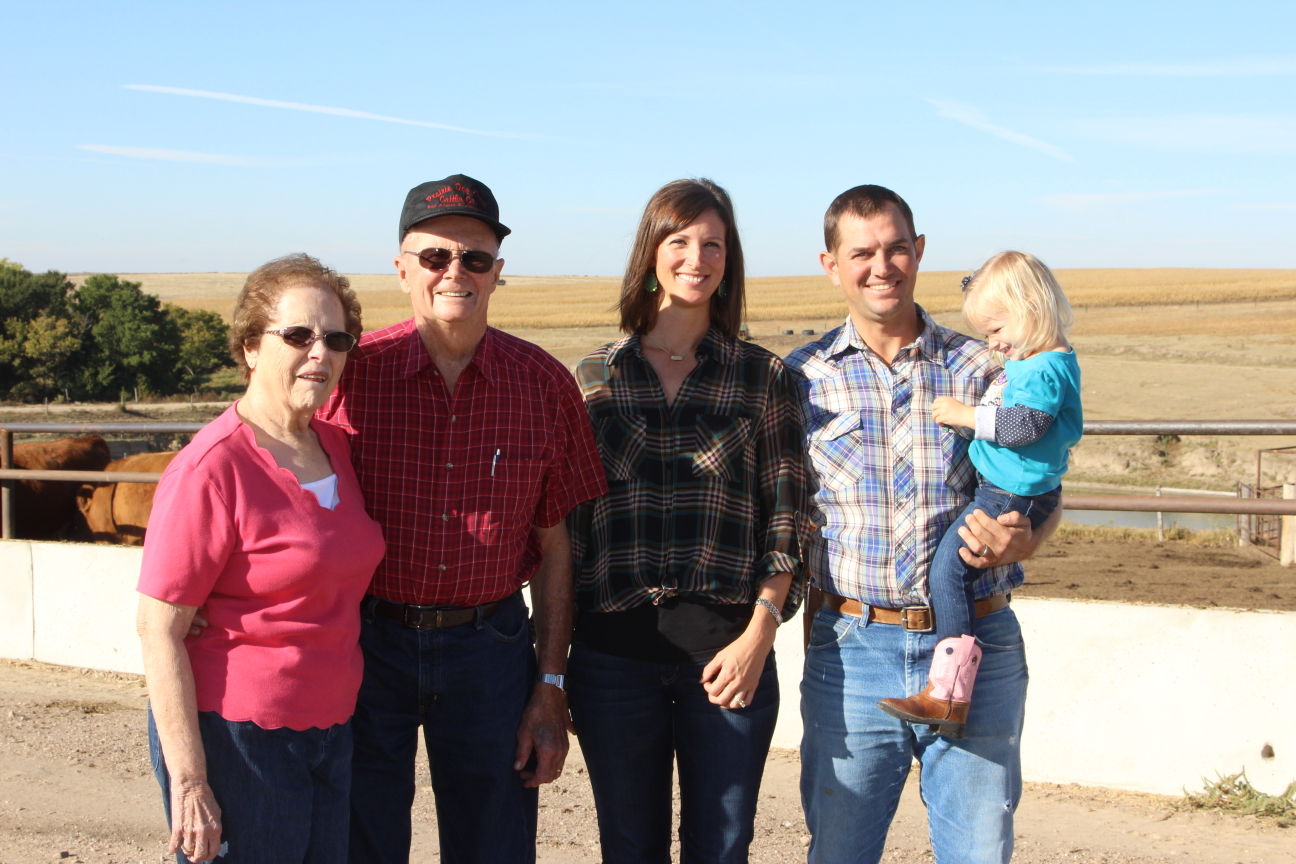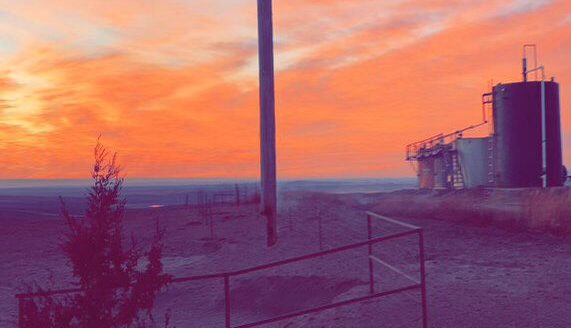It could be said that to be in the cow-calf business, a rancher has to have an eye on the future at all times.
Whether it’s breeding charts for the next calving cycle, an equipment purchase for the farm or even when to pass the ranch on to the next generation, there should be a plan in place for the next step in the future of the business.
Merlin and Bonnie Anderson always had such an eye to the future.
Merlin came home to Dresden, Kansas, from the Korean War in 1955 and started farming. He married Bonnie in 1956 right after she received her Registered Nurse diploma. Together, they raised three children and worked a lifetime on their commercial Red Angus cow-calf ranch. For decades, they improved their cowherd using innovation and always with that goal of improving the herd each step of the way.
So, it was only natural they would use the same philosophy when choosing how to pass on the business and to whom.
And that’s where Michael and Kelly Wasson enter the picture.
The Wassons were fresh out of college and just starting their married life together when they came back to the Dresden area about 14 years ago. Michael had grown up just a few miles down the road from the Andersons and is distantly related. So he was familiar with the family and their commercial Red Angus-influenced cow-calf operation.
When the Andersons learned the Wassons were looking for a place out in the country, they offered up a small house they happened to have vacant in exchange for the young couple helping calve out heifers for the ranch.
“We knew we wanted to live in the country, and we’d just finished school and so we calved out their heifers for two years,” Michael said. But then, he and Kelly decided they wanted to spread their wings a little bit and actually use their college degrees outside of Dresden and pick up some practical, real-world knowledge. So, the young couple found jobs in Nebraska and went to tell the Andersons they would be moving.
“We told them we wanted to leave, but they countered and said, ‘We want to sell you the place,’” Michael said.
Bonnie and Merlin never hinted it to the young couple, but they’d been quietly thinking about their future retirement and the future of the ranch they’d built together. Those couple of seasons of calving out heifers proved to the Andersons that the Wassons were a good fit.
Still, the Wassons knew that to be the very best they could be at running any ranch they needed to gain knowledge from outside their professors and outside of their family. So, they thanked the Andersons and then went on ahead and started careers in Nebraska. Michael had a job in agronomy, while Kelly worked processing agricultural loans and learning about the finance business.
A few years passed, and Michael and Kelly felt it was finally time to take their built up skills and settle back home. Fortunately the offer was still on the table from Merlin and Bonnie. So the two couples struck a deal.
The Wassons would buy the farm, the house, the equipment, the cattle—all of it. And, to help the young couple, the Andersons would do so on a long-term plan where the livestock were put on a lease-to-purchase agreement and the real estate financed by Merlin and Bonnie.
But, beyond the physical property that changed hands, the Wassons also got an intangible benefit. Merlin and Bonnie would pass on the wisdom of decades of experience in the cow-calf business as mentors to Michael and Kelly.
“I thought I knew a little about cattle,” Michael said. “I grew up raising cattle. But Merlin has so much more knowledge in the records he’s kept. I think he has records that go clear back to 1956.” The Wassons agreed having the Andersons nearby for counsel was invaluable to making the purchase of the farm work.
“I’d ask his opinion a lot,” Michael said. “I know there were times he’d ask me a question, but I know he knew the answer, he was just looking for a different angle. For us, it was the best way to learn.”
Passing on his knowledge and his accumulated data for herd improvements was important to Merlin as much as it was finding the right buyers for the ranch. Whether it was being one of the first in the county to start weighing calves at weaning in the 1950s to measure progress in the herd, or learning how to artificially inseminate cows to better improve genetics in the 1970s, or using performance test data in bull selection in the 1980s, Merlin made sure each step made the herd better.
For example, when he first started out, Merlin’s grandfather and father primarily raised purebred Hereford cattle. But he had heard about the benefits of crossbreeding on finished cattle weights. So, he started bringing in some Red Angus into the Herford herd, as well as some Simmental.

“The Red Angus worked really good with the Hereford, but I liked the Simmental better and I wanted to put on the weight,” Merlin said. Eventually, the herd was a Simmental-Red Angus commercial herd with a heavy influence on Red Angus genetics, and in 1997, the Andersons received the Beef Improvement Federation’s Commercial Producer of the Year award.
One of the lessons that the Andersons shared with the Wassons is to feed out their own calves on the farm so that they can track carcass trends in their cattle.
“Our primary goal was always performance and carcasses,” Merlin said. That goal is still there with the Wassons, Michael echoed, with growth and carcass as their end goals for their selection decisions.
“We feed all our calves here and ship them on a grid,” Michael said.
Keeping those goals in mind helped quite a bit when they had to cull the herd 20 percent three years ago in the midst of the drought. Drought hits the pocketbook hard, but it can also be an opportunity to really take a critical look at the performers in the herd and ship those females who aren’t performing at their peak. Culling decisions can be tough, but they mean just as much to the future of the herd as buying the right herd sire.
“Most will just sell the old cows, but we wanted good heifers,” Michael said. They wound up keeping some older cows with proven fertility and growth, he added.

Michael and Kelly have developed their eye for the future of the herd and are looking into innovations they can use to improve each generation of calves on the place—just like Merlin and Bonnie. The Wassons already use EPDs in bull selection decisions, but in the future they want to start DNA testing their females through the Red Angus Association of America’s Herd Navigator Program. Michael and Kelly like to use bulls that are Red Angus crosses on their Red Angus commercial cows, just to add hybrid vigor into their calf crop. But they’d also like to explore embryo transplanting. And, eventually, Kelly said she’d like to talk Michael into a small registered Red Angus herd on the place as well as the successful commercial cowherd.
Still, there’s some things that you select for based on the country you run cattle in, and one piece of advice on cattle selection came from Bonnie.
“You look at their feet,” she said. For years the Andersons selected replacement cattle based on if they had good conformation to handle traveling long distances in pastures, if they could keep their feet under themselves. It’s something the Wassons look at too when selecting replacements today.
Today, the Wassons fully own Prairie Dog Creek Cattle Co. Their three children Michaela, 8; Mitchell, 5; and Macy, 2, are growing up in the country, just like Michael and Kelly had hoped for when they started out as that newly married couple.
Sitting around the Wassons’ dining room table, the two couples reminisced about the arrangement that’s been so beneficial to both families. There were a lot of pieces that fell into place that made this a successful transition.
“They have to have integrity and a work ethic,” Merlin said. “That has to be there in order for this sort of thing to be a success.” For the Andersons, there’s a peace of mind knowing what they built is in the hands of people who not only value the work they put into it, but who will continue the legacy.
While it was a difficult decision to make to sell the farm, doing so on a lease-to-purchase agreement made it beneficial to both parties for financial reasons. But still, it helped that the Andersons and the Wassons had and continue to have the day-to-day mentoring relationship inside and outside of the business.
“For us, if something works, then you should keep doing it,” Michael said. “That, and surround yourself with successful and positive people.” The Wassons both agreed that leaving for a while and spreading their wings in careers off the farm gave them not just independence, but invaluable perspective into how others conduct business and a list of contacts they can turn to for advice.
It’s an unusual agreement, to be sure, but the Wassons also agreed this sort of mentoring relationship, along with a business purchase, can be a way to bring fresh blood to rural communities.
“Rural businesses need this sort of thing bad,” Michael said. Not just farmers and ranchers, but those contractors and small business owners in towns who are looking at their own retirement plans, he added.
Because, if there’s anything that the Andersons know and have passed on to the Wassons, it’s this: Keep your eye on the big picture, and do all you can to improve every step of the way for your future success.
Jennifer M. Latzke can be reached at 620-227-1807 or jlatzke@hpj.com.




